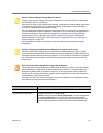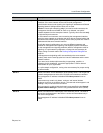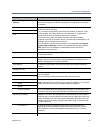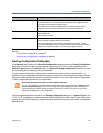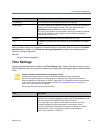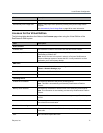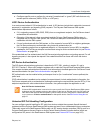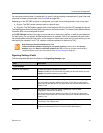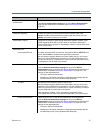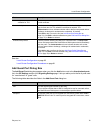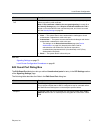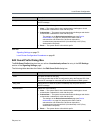
Local Cluster Configuration
Polycom, Inc. 72
See also:
Local Cluster Configuration on page 63
Local Cluster Configuration Procedures on page 81
Signaling Settings
On the Signaling Settings page, you can configure H.323 and SIP signaling.
H.323 and SIP Signaling
If H.323 signaling is enabled, the Polycom RealPresence DMA system’s Call Server operates as a
gatekeeper, receiving registration requests and calls from H.323 devices. If SIP signaling is enabled, Call
Server operates as a SIP registrar and proxy server, receiving registration requests and calls from SIP
devices. If both are enabled, the system automatically serves as a SIP <–> H.323 gateway.
As a best practice, we recommend configuring your videoconferencing network in such a way as to avoid
using the RealPresence DMA system as a SIP <--> H.323 gateway.
Either H.323, SIP, or both must be enabled in order for the RealPresence DMA system’s Conference
Manager to receive calls for multipoint conferences (virtual meeting rooms, or VMRs) and distribute them
among its pool of MCUs.
On this page, you can also:
● Turn on H.235 authentication for H.323 devices.
● Turn on SIP digest authentication for SIP devices.
● Click a Device authentication settings link to go to the Device Authentication page, where you
can configure SIP device authentication and maintain the inbound device authentication list for both
H.323 and SIP devices (see Device Authentication on page 261).
Date accepted The GMT date and time of EULA acceptance.
Automatically send usage data Select to help improve this product by sending anonymous usage data to
Polycom.
See Automatically Send Usage Data on page 85 for more information.
Note: Supercluster-wide Signaling Settings
Although these are cluster-specific settings that are not part of the data store shared across
superclustered systems, we strongly recommend that all signaling settings be the same across all
clusters in a supercluster.
The settings for untrusted SIP call handling (“unauthorized” or “guest” calls) must be the same across
all clusters in a supercluster.
Note: Authentication for Specific Devices
You can turn authentication off and on for specific devices (assuming that it’s turned on here for that
device type). See Edit Device Dialog Box on page 97.
Field Description



